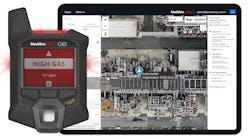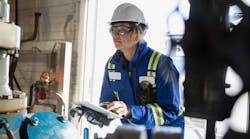June 01--As flames and explosions consumed a Marietta chemical warehouse days ago, authorities assured the public that nothing toxic was being spewed into the night sky.
But they didn't really know.
The fire burned for at least two hours before anyone checked for dangerous emissions. And it took about four hours for the U.S. Environmental Protection Agency to begin more extensive air testing that might have detected chemicals kept at the warehouse.
That delay was crucial. It could have left time for a witch's brew of chemicals to billow out to surrounding neighborhoods, an Atlanta Journal-Constitution examination found.
While officials say they didn't detect toxic fumes, experts say that chemicals are most likely to escape in the beginning stages of a fire. Once a building is fully engulfed, as happened at the Amrep warehouse a week ago, the chemicals have been incinerated.
"We honestly don't know what chemicals were released," said Battalion Chief Scott Demkowski, who coordinated the Cobb County fire department's hazmat team during the May 23 fire.
The blaze exposed a vulnerability in protecting populations against catastrophes at industrial sites, where it is imperative not only to fight the fire but also to quickly assess the threat from emissions.
It is particularly important with a place like Amrep, where so many things can go wrong.
"The Amrep facility was full of extremely toxic chemicals, like heptane, sulfuric acid and toluene, all of which are hazardous to our health and become even more dangerous when they catch on fire," Colleen Kiernan, director of the Sierra Club's Georgia chapter, said in an email. "Right now, we don't know what happened and whether Marietta residents were exposed to dangerous chemicals."
As it was, runoff from a mix of firefighting floam and plant chemicals likely caused a fish kill downstream from the warehouse, the AJC learned.
The scene of fires, mishaps and environmental violations in the past, the company keeps both toxic and volatile chemicals on its site. Part of the reason air monitoring didn't start sooner was that firefighters were more worried about the heptane and butane pressurized tanks just outside the warehouse exploding.
Their first priority was putting out the hellish blaze, which was reported just after 8 p.m. and took until 4 a.m. to completely extinguish. Multiple explosions shot mushrooms of bright orange flames hundreds of feet above the warehouse. A plume of pitch-black smoke could be seen from downtown Atlanta to Cherokee County.
The warehouse didn't have a sprinkler system. It was so old, it had grandfather exemption from the city's requirements. A report the company submitted to environmental regulators shows that the warehouse was used for aerosol storage and hazardous waste, but in a report to the Securities and Exchange Commission on Tuesday, the company said the building housed the company's chemical raw materials and some finished products.
Investigators haven't determined what started the fire, though arson has been ruled out. No one was seriously injured, though the company's report to SEC said two employees reported suffering injuries.
Emergency crews did immediately go door to door evacuating businesses within a mile's radius of the warehouse, Marietta Police Officer David Baldwin said. They also emptied a nearby soccer arena and the sports fields at The Walker School, he said.
Firefighters, meanwhile, had pulled up Amrep's chemical inventory online. Among the materials are several that may cause cancer and others that pose risks of brain damage and impaired development in children. But that was the inventory for the entire Amrep complex, and it didn't specify what was in the warehouse at the time.
Demkowski said he sent out two teams with air monitors to rove neighborhoods downwind of the plume. He said he doesn't recall the time, though the Marietta Fire Department estimates testing started around 10 p.m. The Cobb teams detected nothing, so authorities decided not to notify residents in a wider radius of the fire, believing there was no threat.
The fire department was checking for carbon monoxide and explosive gases.
More comprehensive testing didn't occur for another two hours, when EPA set up seven monitors within about three-quarters of a mile eastward of the plant. Stephen Ball, the EPA's on-scene coordinator, said some of the meters tested for the presence of volatile organic compounds from some of the chemicals known to be stored at the facility, while others tested for particulates as a general measure of air quality. The monitors detected nothing.
Ball said that if the toxic substances at the plant had been released, he would have detected them, even four hours later. EPA officials called that a "rapid response time," and typical of such emergencies.
"If it's going to get released," Emergency Response Section Chief Jose Negron said of toxic chemicals, "the best way is by burning it ... That's probably the best way to get rid of it."
But in the beginning stages of a fire, especially after an explosion, chemicals may not be fully incinerating, but burning slowly and incompletely, contaminating the air. That's the best time to start testing for toxic emissions, not hours later, a fire and explosion expert said.
"You want to get the measurements very early," and for the duration of the fire, said Albert Moussa, president of BlazeTech Corp., an engineering consulting firm in Massachusetts. "The sooner the better, obviously."
The longer the wait, and the more material there is in a fire, the more difficult it is to contain emissions and the potential for some sort of consequence goes up, said Dr. Richard G. Gann, a senior research scientist emeritus at the National Institute of Standards and Technology.
But having resources available for an immediate response to such infrequent events may be a question not only of safety practices but also of funding and community priorities, he said.
Tests themselves aren't perfect, as the Amrep fire showed.
Both Cobb's fire department and EPA detected no contamination of a nearby stream, and yet, days later, fish turned up dead miles away in East Cobb. Georgia Environmental Protection Division spokesman Kevin Chambers said three to five miles of Sope Creek was contaminated, probably by a combination of plant chemicals and firefighting foam.
On Memorial Day, Corinne McNamara and her children were wading in the creek in Weatherstone subdivision when she spotted about a dozen dead minnows and catfish and one dead crayfish. The tint of the water didn't look right, either.
She went home and scrubbed herself and her kids with soap and water. She later called Chattahoochee Riverkeeper, which helped her make the connection to the Amrep blaze.
"These chemicals are killing the animals and fish in our creek, so how could it not affect humans?" McNamara said. "The question is how much is it going to affect us, and that just makes me irate."
Almost 58,000 people live within a three-mile radius of Amrep, EPA records show.
The plant, which produces aerosol automotive and cleaning products, has been fined repeatedly over the years for air quality and safety violations. It also has been under orders to clean up contaminated soil at the site. In its annual financial reports, the company has estimated that soil cleanup could cost as much as $10 million.
EPA's toxic release inventory shows the plant emits a variety of chemicals into the air, including some potential carcinogens.
The company's fines for pollution violations include a $10,000 settlement with the Georgia Environmental Protection Division in 2010 for violations of its air quality permit, and a $38,000 settlement with EPD in 2008 for the company's failure to meet a consent order for installation of pollution control equipment. EPD records also show that the company had a known release of vinyl chloride in groundwater at levels exceeding the reportable quantity, along with a variety of other chemicals.
The federal Occupational Health and Safety Administration also has investigated and fined the company following accidents that killed or injured employees. In 1997, a flash fire started while employees were using a flammable liquid to clean a sticky floor. Two workers were burned, one of whom died about a month later. In 1999, another flash fire in a mixing tank severely burned an employee.
Another worker lost both legs in 2001 when he got stuck in a cardboard compacting machine. OSHA's last inspection of the company was in November 2007.
In January 2010, the company was sold to Zep Inc., which operates other plants that make a wide range of cleaning and maintenance solutions.
This past March, Amrep celebrated 1.5 million work hours without an injury that caused missed work time.
Calls to Amrep were routed to Zep. Bob Collins, vice president and chief administrative officer, said the company was excited that all employees made it out safety. "The EPA and the police department tested and confirmed that the fumes from the fire were not toxic, and we have no reason to believe any differently," Collins said. "We're focused on the investigation and the recovery efforts, and looking forward to finding out what happened and moving forward."
Collins said he would have Amrep supply a list of chemicals in the warehouse. Instead, the AJC received an email from a spokeswoman, who declined to discuss what specific materials were in the warehouse before the fire, referring questions to EPA.
EPA said in an email it "has no knowledge of which chemicals may have been released and/or consumed in the fire."
Copyright 2014 - The Atlanta Journal-Constitution





